
With the digital world awash with malware, viruses and vulnerabilities, it’s hard to avoid security breaches. But does zero trust security have the answer?
Hundreds of thousands of new malware strains are created daily; the chances, therefore, of your organization being targeted are high. Typically, we use measures such as security education to enhance vigilance and tools such as anti-malware software to minimize breaches. But neither of these are 100% secure. In fact, no one security measure can ever be 100%. It’s possible, though, to maximize your security by introducing additional security measures. And this is where zero trust security can make a big difference.
The Lowdown on Zero Trust
When users log on to corporate networks, they are usually assigned a certain level of access control. This allows them to access the parts of the network that are required for them to do their job. So, for example, an employee in the finance department would have access to invoicing systems whereas this would be restricted to those in the marketing department. Such an approach allows you to limit unauthorized access to sensitive data. But the zero trust model takes things a step further.
Zero trust’s guiding ethos is one of “never trust, always verify” and it takes a hardline approach to access privileges. Rather than assuming that a device in a specific location should automatically be granted access to the network in that area, zero trust access demands verification every time resources are accessed. Instead of providing an element of trust, there is zero trust – hence the name of the model. It’s an approach which requires checking both the identity and health of the devices requesting access alongside mutual authentication.

How Can Zero Trust Help?
A significant number of security breaches are down to human error e.g. opening a malicious email attachment. But zero trust work to eliminate (or at the very least, minimize) this human error by bringing access control to the table. External devices, for example, can’t gain access to a secure network by using stolen network credentials – they need to prove that the device in question is authorized and that the user can provide authentication. Not only does this limit unauthorized external access to your network, but it limits the number of internal users who can access data which is unnecessary to their role.
Final Thoughts
Access control has been in place with IT infrastructures for decades, but the hardline model of zero trust access is one that all businesses should be shifting towards. In particular, large businesses with a multitude of different departments and employees are particularly at risk of security breaches. But this is only the case if all employees have access to the same resources. Questioning the integrity of specific devices – and foregoing any assumptions based upon location – is crucial when it comes to protecting your network.
If your organization does not already practice the zero trust model for access, then it’s time to get started. Plan your model by dividing your networks into specific sections and detailing who needs access to each one. You can then start putting additional security in place – such as two factor authentication – to strengthen your network and keep your data as safe as possible.
For more ways to secure and optimize your business technology, contact your local IT professionals.







